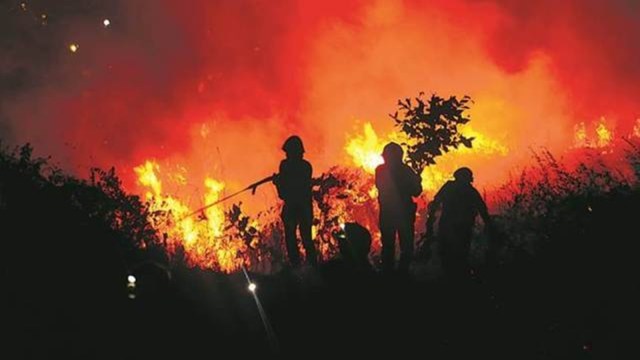Sudden spike in forest fires in southern India due to heat, clear skies
For nearly a week now, forest fires have been raging in the Coonoor forest range in the Nilgiris in Tamil Nadu
 FSI estimates suggest that nearly 36 per cent of India's forests are prone to fires of which about 4 per cent are highly prone. (Representational photo)
FSI estimates suggest that nearly 36 per cent of India's forests are prone to fires of which about 4 per cent are highly prone. (Representational photo)High aridity, above normal day temperatures, clear sky conditions and calm winds during this early phase of the summer season could be some of the contributory factors for sudden spike in the forest fire incidents reported from southern India regions.
For nearly a week now, forest fires have been raging in the Coonoor forest range in the Nilgiris in Tamil Nadu. On Sunday, the Indian Air Force deployed Mi-17 V5 helicopters to conduct Bambi Bucket operations that discharged 16,000 litres of water, joining the ongoing efforts by the state forest department to douse the wild fires.
“Generally, forests in southern India are less prone to fires as the vegetation type is largely evergreen or semi-evergreen. On the contrary, the forests in northeast India, Odisha , Maharashtra, Jharkhand, Chhattisgarh and Uttarakhand are largely covered with dry deciduous forests, making them more vulnerable to fires during November t0 June period,” a Forest Survey of India (FSI) report said.
FSI estimates suggest that nearly 36 per cent of India’s forests are prone to fires, of which about 4 per cent are highly prone.
Some forest areas in Andhra Pradesh and Telangana are fire prone but Tamil Nadu has been reporting wildfires in the forests in recent years. One of the main reasons this year is the above average temperatures.
February ended up being exceptionally hot over the country, especially southern India. The month was south India’s hottest since 1901 and so was January, which was fifth warmest in over a century. For the past two months, the recorded maximum, minimum and mean temperatures remained above normal over the southern states, building the heat load over the region well before the onset of the summer season. As a result, there has been an early availability of dry biomass in these forests since the winter season itself.
The India Meteorological Department (IMD) recently warned of prevalence of an Excess Heat Factor (EHF), a value that predicts the chances of heatwave over the region, to be significantly higher than normal over western Andhra Pradesh and neighbouring Karnataka region. Here, the maximum temperatures last week touched 40 degrees Celsius, unusual for mid March.
In the absence of pre-monsoon rainfall and prevailing high temperatures, the IMD has classified almost all of southern India districts under ‘mild’ aridity, suggesting 75 per cent of the district to be arid.
Over rest of the country, the FSI data noted the highest number of forest fires were reported from Mizoram (3,738), Manipur (1,702), Assam (1,647), Meghalaya (1,229) and Chhattisgarh (1,183) during the past one week. Satellite data of Monday, generated by the Indian Space Research Organisation (ISRO) tools, revealed that the forest fires have been on an uptick since early March along Konkan belt in Maharashtra, south-coastal Gujarat along Gir Somnath and Porbandar, southern Rajasthan and adjoining south-western districts of Madhya Pradesh, most forest covered areas of Andhra Pradesh, Karnataka and Tamil Nadu. High EHF values prevailed also over interior Tamil Nadu , coastal and interior Odisha and adjoining Jharkhand, the IMD said.







